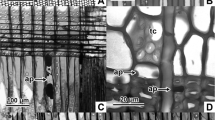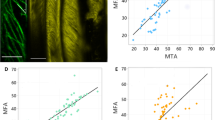Abstract.
The microtubule (MT), microfilament (MF) and myosin components of the cytoskeleton were studied in the long-lived ray and axial parenchyma cells of the secondary xylem (wood) and secondary phloem of two angiosperm trees, Aesculus hippocastanum L. (horse-chestnut) and Populus tremula L. × P. tremuloides Michx. (hybrid aspen), using indirect immunofluorescence localisation and transmission electron microscopy. MTs and MFs were bundled and oriented axially (parallel to the cell's long axis) within all parenchyma cell types after they had fully differentiated. Additionally, actin and myosin were immunolocalised at the thin-walled membranes of the pits, which linked cells in neighbouring files of both ray and axial parenchyma, and at the pits between axial and ray parenchyma cells themselves. Anti-callose antibody immunolocated the plasmodesmata at the pit membranes, and in the same pattern as that of anti-myosin. Ray cells are important symplasmic pathways between the xylem and the phloem throughout the life of trees. We hypothesise that the MT and MF components of the cytoskeleton in the ray and axial parenchyma cells are involved in the transport of materials within those cells, and, in association with the acto-myosin of plasmodesmata at pit fields, are also important in intercellular transport. Thus, the symplasmic coupling between ray cells, between axial parenchyma cells, and between axial parenchyma and ray cells represents an extensive three-dimensional communication pathway permeating the tree from the phloem through the cambium into the wood. We suggest that this cytoskeletal pathway has an important role in delivery of photosynthate, and mobilised reserves, to the actively dividing cambium, and in the movement of materials to sites of reserve deposition, principally within the wood. This pathway could also have an important role in co-ordinating developmental processes throughout the tree.
Similar content being viewed by others
Author information
Authors and Affiliations
Additional information
Electronic Publication
Rights and permissions
About this article
Cite this article
Chaffey, N., Barlow, P. The cytoskeleton facilitates a three-dimensional symplasmic continuum in the long-lived ray and axial parenchyma cells of angiosperm trees. Planta 213, 811–823 (2001). https://doi.org/10.1007/s004250100560
Received:
Accepted:
Issue Date:
DOI: https://doi.org/10.1007/s004250100560




